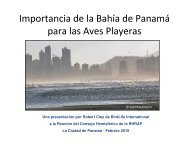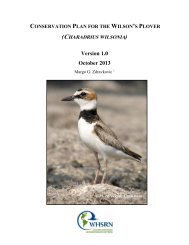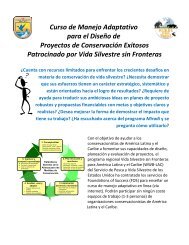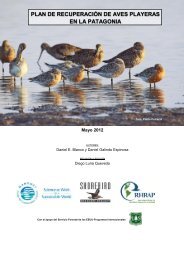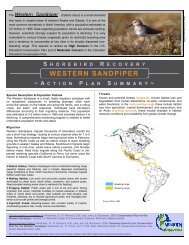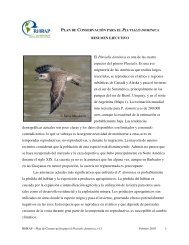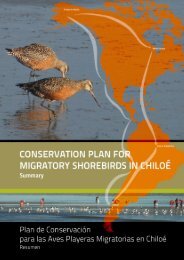Sanderling Plan - Western Hemisphere Shorebird Reserve Network
Sanderling Plan - Western Hemisphere Shorebird Reserve Network
Sanderling Plan - Western Hemisphere Shorebird Reserve Network
You also want an ePaper? Increase the reach of your titles
YUMPU automatically turns print PDFs into web optimized ePapers that Google loves.
Upper Mississippi/Great Lakes Region (Joint Venture Area) (de Szalay et al. 2000):<br />
o Set regional goals for amount of habitat to be maintained/protected/restored, e.g., begin<br />
by setting aside a minimum of 1,500 hectares beach habitat for foraging and resting<br />
<strong>Sanderling</strong>s and other beach-using shorebirds during peak migration periods.<br />
Northern Pacific Coast Region (Drut and Buchanan 2000):<br />
o Determine the current population status of the <strong>Sanderling</strong> within the region, and monitor<br />
this species to determine long-term trends;<br />
o Determine the potential impacts of environmental contaminants on the health of<br />
shorebird populations;<br />
o Improve communication among and within resource management agencies about<br />
shorebird needs and management techniques.<br />
Southern Pacific Coast Region (Hickey et al. 2003):<br />
o Increase migratory and wintering populations of all key shorebird species in the region<br />
using protection, restoration, enhancement, and management;<br />
o Minimize future introductions of non-native invertebrates and plants;<br />
o Ensure adequate low-disturbance roost sites.<br />
HABITAT RESTORATION AND CREATION<br />
Habitat restoration is not an adequate substitute for safeguarding existing wetlands<br />
(Buchanan 2000). However, in cases where further habitat loss is inevitable, there is potential for<br />
habitat restoration or creation to possibly mitigate environmental impacts. Information regarding<br />
the effectiveness of restoration efforts is limited, and restoration approaches carry risks.<br />
However, some suggestions may increase probability of success (from Buchanan 2000):<br />
o Develop site-specific strategies for restoration projects – Consider site characteristics<br />
such as tidal, wind pattern, sea swell, and substrate conditions (marine environment) or<br />
local water, soil, and vegetation conditions/requirements (freshwater);<br />
o Create new sites at least 5 years prior to modification of natural habitat - Artificially<br />
created sites should accommodate all displaced birds, initiating this process at least 5<br />
WHSRN – <strong>Sanderling</strong> Conservation <strong>Plan</strong>, February 2010, v1.1 57




